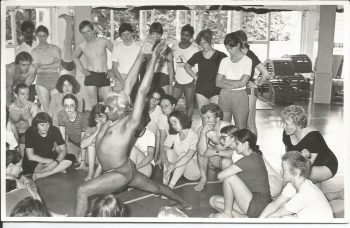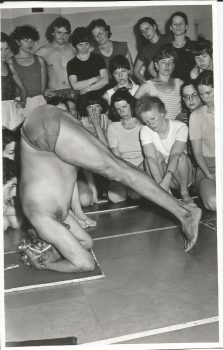Adapting to teaching and learning online has given rise to lots of discussion here at Yoga Now. Here are Katie Rutherford’s musings on the subject.
It feels a bit like we have been swept along a wind tunnel, or down a rabbit hole to wonderland, since lockdown in the yoga world, coinciding as it has with the zoom phenomenon and our ability to connect from the silence of our personal yoga spaces to hundreds, if not thousands, of fellow practitioners around the world. Overnight we have an unlimited choice of teachers and classes which surely must be having a deep effect on our mental states. Does this help us on our path towards restraint? Chitta vritti nirodha? For all its very obvious and much vaunted advantages, it does seem that the digital age continues to throw more obstacles onto the path, exacerbating rather than attenuating the kleshas.
Among other things, I have been spending my lockdown reading Prashantji’s books cover to cover and listening to all the Sunday morning RIMYI sutra sessions that I didn’t have time to in my old life. Or, more truthfully, that that I didn’t “find” the time to. One of the ways he describes “abhyasa” is “any effort to stabilise the mind, psychologically” since “we don’t do yoga because the mind is quiet, we do yoga to make the mind quiet”. And “vairagya” is a “thirstlessness for objects of this world”. Our yoga sadhana teaches us to neutralise the mind so we don’t feel the polarities of attraction and aversion, pain and pleasure, gain and loss, shame and praise – rather we mitigate the clamour, which all come because of the “me”.
But oh what a clamour is there! All this learning to be had and what to choose! The fear of missing something great. Like being in a funfair with all those rides and limited time. Or a market full of shiny things to make our lives and practice better. The magnetic pull that marketeers exploit so well. I’ve heard the expression “yoga junkie” being used a couple of times.
And yet it is a good thing, no? How can you have too much yoga? And too many classes? With all these wise and wonderful teachers?
From a student’s perspective I would imagine that concentration could improve as there are fewer distractions, less competition, looking at others, being able to break wind without embarrassment (!), and a much sharper demand on your listening skills without others to copy. A good opportunity to learn the Sanskrit names. Also, it would depend on how an individual prefers to learn – whether more visually or through audio. And, of course, the convenience of not needing to leave home, controlling your own room temperature, and the fridge just round the corner when the class is finished. Personally, I’ve only done a couple of classes and had the eerie sense of being alone in a huge crowd, a contrast to the deep quiet which accompanies my own practice. As a seeker of sattva guna (another of Prashantji’s spot-on descriptions of our level of yoga sadhana) my inner teacher is by far the most effective at transforming my raja and tama guna.
We are all different.
Teaching yoga online presents many challenges. Your view of the student is limited, even if they do adjust the camera skilfully for the various asanas, you can’t always see well and clearly where they are going wrong and where they need adjustment. This is unsettling if you know they have an injury or an instability or a tendency to overwork. What is their state of mind? How are they breathing? Has their colour changed? How do their eyes look? Do you teach more challenging or more restorative? How is the balance of raja and tama guna? How can you have any degree of intimacy with them to get to know them? How many should be the maximum or should everyone be allowed to come? Are they coming just to do a good practice or do they want to learn?
 It seems such a long way from the Guru/Shishya relationship. Here are a couple of photos from 1981 when a small group of Scottish students went on an intensive with Guruji. Look how they are learning! And compare with how we are learning in the age of Covid-19.
It seems such a long way from the Guru/Shishya relationship. Here are a couple of photos from 1981 when a small group of Scottish students went on an intensive with Guruji. Look how they are learning! And compare with how we are learning in the age of Covid-19.
 But, of course, it is better than nothing and we all feel heartfelt gratitude for all those students who continue loyally to attend our regular classes. It is lovely to see your faces each week, to help us all to connect during this period of relative isolation. It is a great honour to help you to build up trust and confidence in your own inner teacher and many of you have reported how doing classes in your own home has helped to establish a home practice.
But, of course, it is better than nothing and we all feel heartfelt gratitude for all those students who continue loyally to attend our regular classes. It is lovely to see your faces each week, to help us all to connect during this period of relative isolation. It is a great honour to help you to build up trust and confidence in your own inner teacher and many of you have reported how doing classes in your own home has helped to establish a home practice.
And, without doubt the most joyous and heartwarming aspect has been to see those of you who live in remoter parts of Scotland and the rest of the UK able to come to class, and to connect with the community.
And, of course, lockdown itself has given the entire world a chance to stop, pause, and think about the kind of universe they want to live in. The lack of time and social pressures has meant time to reflect and immerse yourself in yoga sadhana and feel deep gratitude for its place in your life. For many of us it has become even more enriching as a result of this enforced isolation. I am so grateful to my inner teacher for uncovering an action that has opened up for me a deep new seam of understanding – perfect timing, since sharing it has helped give meaning and direction to my Zoom teaching.
I listen to voices saying that this change is here to stay, that online is the way to go, that classes can be “live-streamed” but personally I long for normal classes to return, to feel the energy of the community, to learn and grow with others. Once again to nurture and share with each other rather than feel lost and overwhelmed in this global Zoom community. And to cherish our own practice as a means of addressing the chitta with our own inner teacher as a guide.
It would be lovely to hear other opinions on this, so do comment or write a piece that we can share with others in the community. These photos provided by Nancy Dickson who was on this intensive in 1981. Thank you Nancy!
Katie Rutherford teaches General, Intermediate and Teachers’ classes and workshops at Yoga Now and is a Mentor to trainee and existing teachers. She has been studying Iyengar Yoga since the 1970s, teaching since the 80s and has visited Pune many times to study with the Iyengar family.



